中考英语二轮语法专项复习课件 第十七讲 状语从句
文档属性
| 名称 | 中考英语二轮语法专项复习课件 第十七讲 状语从句 |
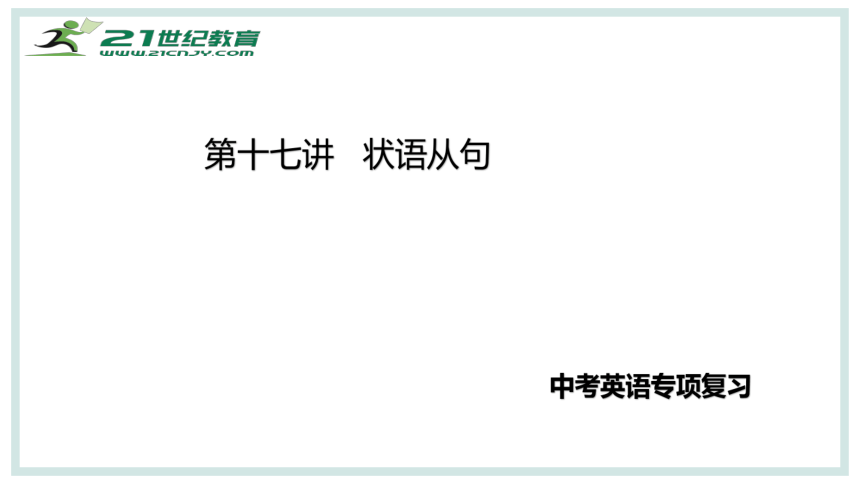
|
|
| 格式 | pptx | ||
| 文件大小 | 1.1MB | ||
| 资源类型 | 试卷 | ||
| 版本资源 | 鲁教版 | ||
| 科目 | 英语 | ||
| 更新时间 | 2024-01-03 21:52:22 | ||
图片预览

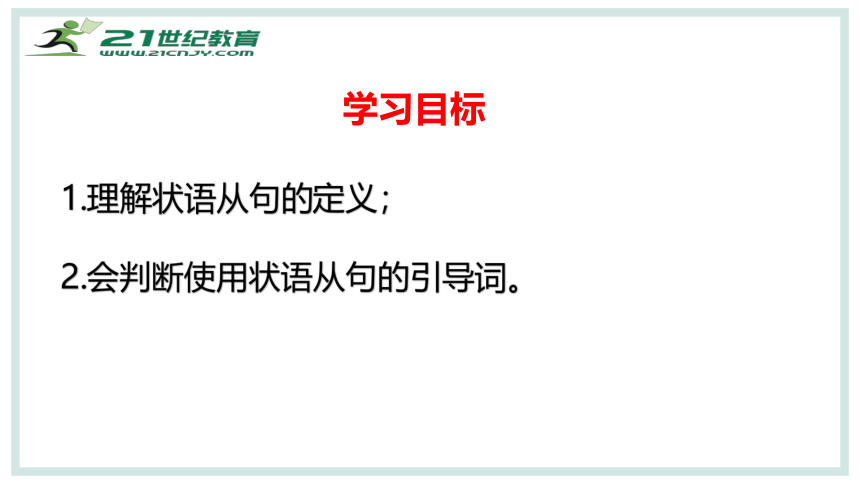
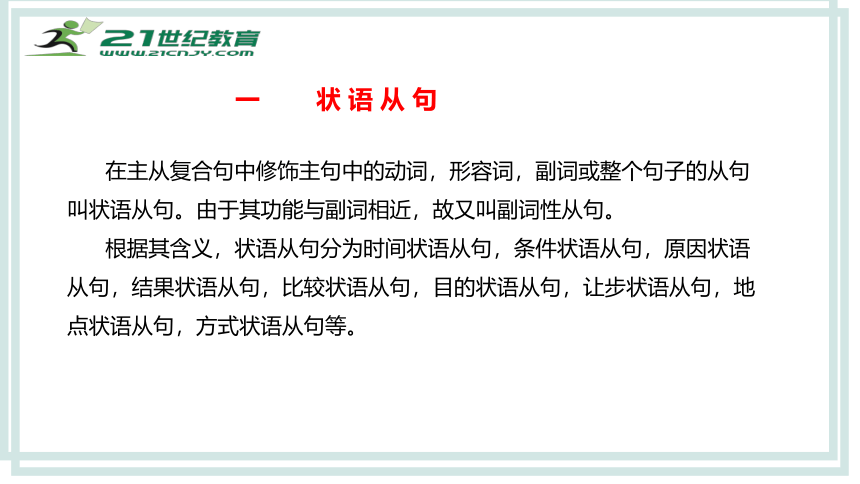
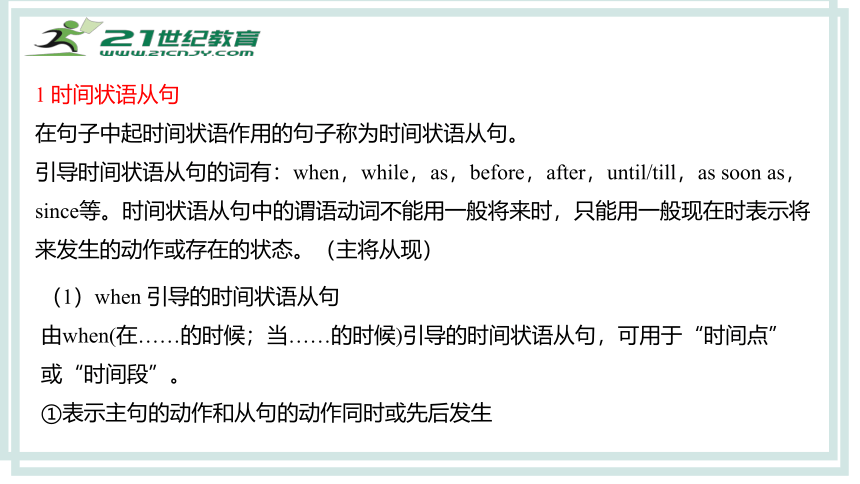
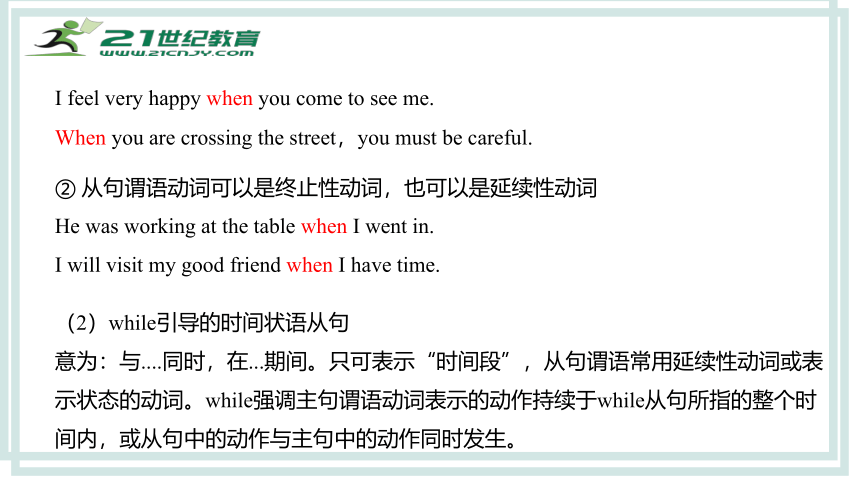
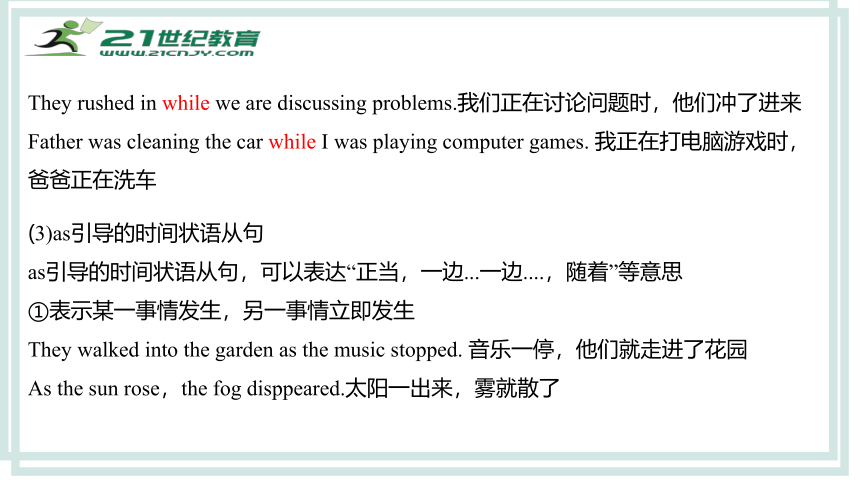
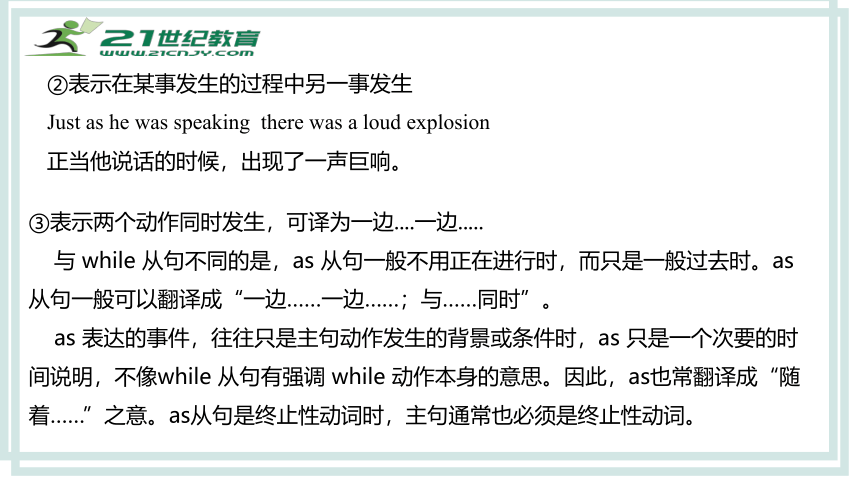
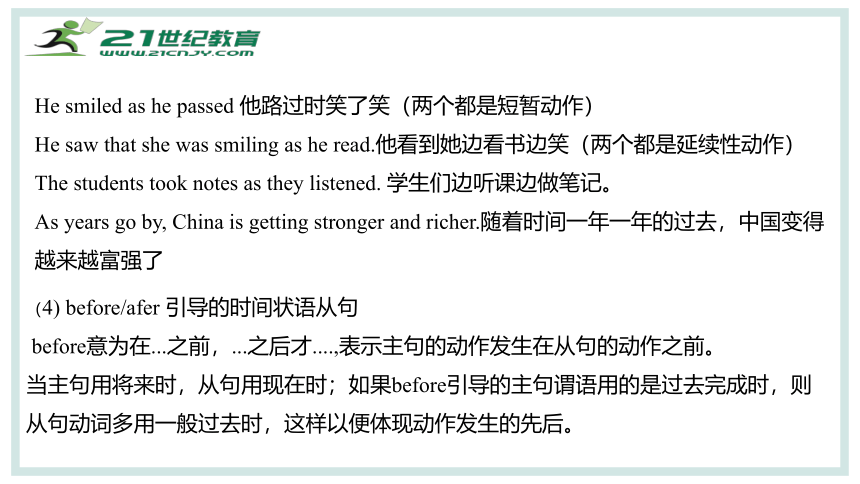
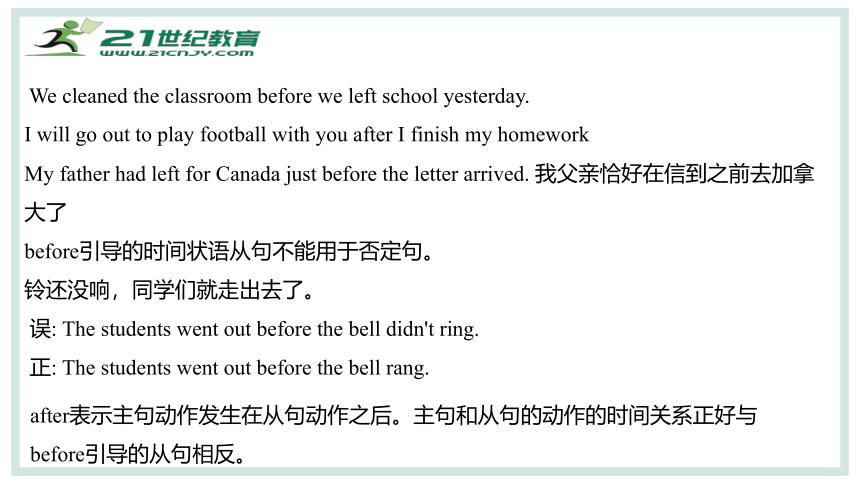
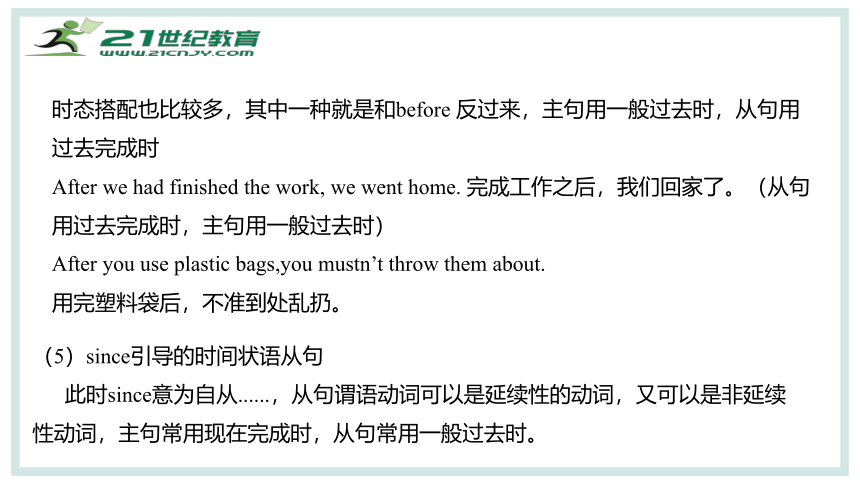
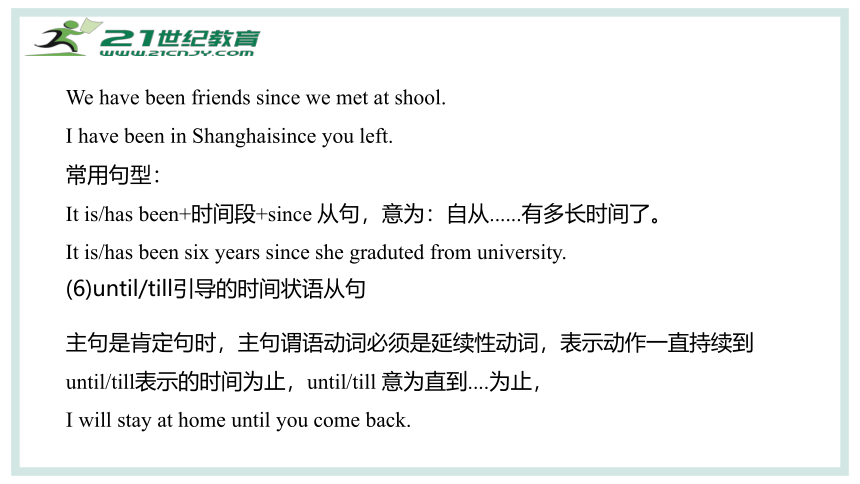
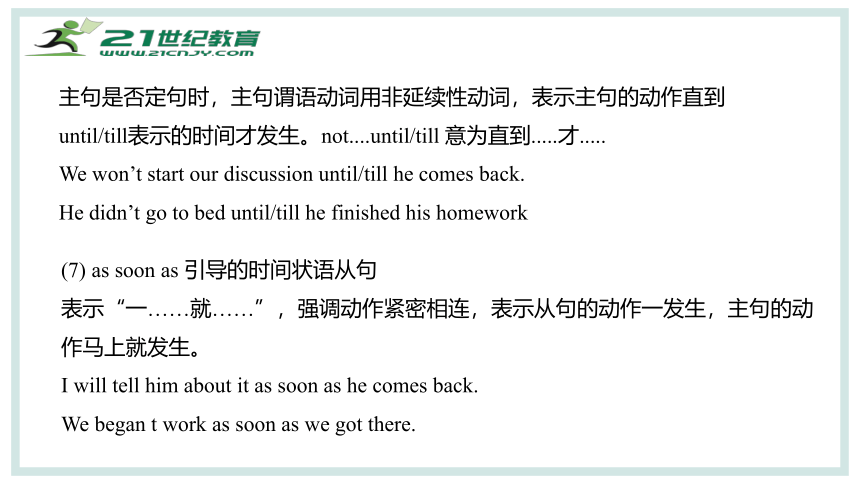
文档简介
(共55张PPT)
第十七讲 状语从句
中考英语专项复习
1.理解状语从句的定义;
2.会判断使用状语从句的引导词。
学习目标
一 状 语 从 句
在主从复合句中修饰主句中的动词,形容词,副词或整个句子的从句叫状语从句。由于其功能与副词相近,故又叫副词性从句。
根据其含义,状语从句分为时间状语从句,条件状语从句,原因状语从句,结果状语从句,比较状语从句,目的状语从句,让步状语从句,地点状语从句,方式状语从句等。
1 时间状语从句
在句子中起时间状语作用的句子称为时间状语从句。
引导时间状语从句的词有:when,while,as,before,after,until/till,as soon as,since等。时间状语从句中的谓语动词不能用一般将来时,只能用一般现在时表示将来发生的动作或存在的状态。(主将从现)
(1)when 引导的时间状语从句
由when(在……的时候;当……的时候)引导的时间状语从句,可用于“时间点”或“时间段”。
①表示主句的动作和从句的动作同时或先后发生
I feel very happy when you come to see me.
When you are crossing the street,you must be careful.
② 从句谓语动词可以是终止性动词,也可以是延续性动词
He was working at the table when I went in.
I will visit my good friend when I have time.
(2)while引导的时间状语从句
意为:与....同时,在...期间。只可表示“时间段”,从句谓语常用延续性动词或表示状态的动词。while强调主句谓语动词表示的动作持续于while从句所指的整个时间内,或从句中的动作与主句中的动作同时发生。
They rushed in while we are discussing problems.我们正在讨论问题时,他们冲了进来
Father was cleaning the car while I was playing computer games. 我正在打电脑游戏时,爸爸正在洗车
(3)as引导的时间状语从句
as引导的时间状语从句,可以表达“正当,一边...一边....,随着”等意思
①表示某一事情发生,另一事情立即发生
They walked into the garden as the music stopped. 音乐一停,他们就走进了花园
As the sun rose,the fog disppeared.太阳一出来,雾就散了
②表示在某事发生的过程中另一事发生
Just as he was speaking there was a loud explosion
正当他说话的时候,出现了一声巨响。
③表示两个动作同时发生,可译为一边....一边.....
与 while 从句不同的是,as 从句一般不用正在进行时,而只是一般过去时。as 从句一般可以翻译成“一边……一边……;与……同时”。
as 表达的事件,往往只是主句动作发生的背景或条件时,as 只是一个次要的时间说明,不像while 从句有强调 while 动作本身的意思。因此,as也常翻译成“随着……”之意。as从句是终止性动词时,主句通常也必须是终止性动词。
He smiled as he passed 他路过时笑了笑(两个都是短暂动作)
He saw that she was smiling as he read.他看到她边看书边笑(两个都是延续性动作)
The students took notes as they listened. 学生们边听课边做笔记。
As years go by, China is getting stronger and richer.随着时间一年一年的过去,中国变得越来越富强了
(4) before/afer 引导的时间状语从句
before意为在...之前,...之后才....,表示主句的动作发生在从句的动作之前。
当主句用将来时,从句用现在时;如果before引导的主句谓语用的是过去完成时,则从句动词多用一般过去时,这样以便体现动作发生的先后。
We cleaned the classroom before we left school yesterday.
I will go out to play football with you after I finish my homework
My father had left for Canada just before the letter arrived. 我父亲恰好在信到之前去加拿大了
before引导的时间状语从句不能用于否定句。
铃还没响,同学们就走出去了。
误: The students went out before the bell didn't ring.
正: The students went out before the bell rang.
after表示主句动作发生在从句动作之后。主句和从句的动作的时间关系正好与before引导的从句相反。
时态搭配也比较多,其中一种就是和before 反过来,主句用一般过去时,从句用过去完成时
After we had finished the work, we went home. 完成工作之后,我们回家了。(从句用过去完成时,主句用一般过去时)
After you use plastic bags,you mustn’t throw them about.
用完塑料袋后,不准到处乱扔。
(5)since引导的时间状语从句
此时since意为自从......,从句谓语动词可以是延续性的动词,又可以是非延续性动词,主句常用现在完成时,从句常用一般过去时。
We have been friends since we met at shool.
I have been in Shanghaisince you left.
常用句型:
It is/has been+时间段+since 从句,意为:自从......有多长时间了。
It is/has been six years since she graduted from university.
(6)until/till引导的时间状语从句
主句是肯定句时,主句谓语动词必须是延续性动词,表示动作一直持续到until/till表示的时间为止,until/till 意为直到....为止,
I will stay at home until you come back.
主句是否定句时,主句谓语动词用非延续性动词,表示主句的动作直到until/till表示的时间才发生。not....until/till 意为直到.....才.....
We won’t start our discussion until/till he comes back.
He didn’t go to bed until/till he finished his homework
(7) as soon as 引导的时间状语从句
表示“一……就……”,强调动作紧密相连,表示从句的动作一发生,主句的动作马上就发生。
I will tell him about it as soon as he comes back.
We began t work as soon as we got there.
(8)时间状语从句的时态:
①主将从现,即如果主句是一般将来时,从句用一般现在时替代一般将来时。
I will visit my good friend when I have time.
②主句是祈使句或者含有情态动词的现在式,从句用一般现在时。
Be careful when you cross the road. 过马路时要小心。
The traffic must stop when the lights are/turn red. 当红灯亮时,车辆必须停下来
③when引导的时间状语从句,主句用过去进行时,从句用一般过去时,
Mom was cooking when I got home.
She was praticing the piano when I called.
这种情况本质就是过去进行时的功能:表达过去某个时间点正在发生的动作,而从句中的动词往往是个瞬间动词,这个动作的发生(如got home,called)刚好对应着过去的一个“时间点”。
④主句从句都用过去进行时,这个时候连词用 while,例如:
While I was doing my homework, mom was cooking in the kitchen.
I was sitting in the sun while my wife was working in the garden.
这种情况其实是考试连词while的含义:在……的过程中,这样从句的动词就需要一个“延续性”动词,才能和 while 配合完美。
⑤since 引导的时间状语从句为一般过去时,主句为现在完成时。
He has made several friends since he came here two years ago. 自从他两年前来到这里,他已经交了好几个好朋友了。
(9)时间状语从句主从句的位置:
大多数情况下,从句可位于主句前,也可位于主句后。如从句在前时,主从句之间必须用逗号隔开.
I was sleeping when he knocked the door.
When he knocked the door, I was sleeping.
(10)when引导的宾语从句和状语从句的区别:
when引导时间状语从句时,意为“当……时候”;
引导宾语从句时,意为“什么时候”。
He didn’t tell me when we would meet again.
When the weather is fine, many families go out for a walk.
---- Do you know when she will come back tomorrow
---- Sorry, I don’t. When she comes back, I’ll tell you.
(11)when,while和as的区别和联系:
①when引导的从句的谓语动词既可以是延续性动词,又可以是非延续性动词。when有时意思为“就在那时”。
文本信息
When he came in, I stopped eating。(非延续性动词)
When I lived in the countryside, I used to carry some water for him.
当的住在农村时,我常常为他担水。(延续性的动词)
We were about to leave when he came in. 我们就要离开,就在那时他进来了。
② while引导的从句的谓语动作必须是延续性的,并强调主句和从句的动作同时发生(或者相对应)。并且while有时还可以表示对比。
While my wife was reading the newspaper, I was watching TV. 当我妻子在看报纸的时候,我在看电视。(was reading和was watching同时发生)
I like playing football while you like playing basketball. 我喜欢踢足球,而你喜欢打篮球。(含对比之意)
文本信息
③ as表示“一边……一边.....”,as引导的动作是延续性的动作时,一般用于主句和从句动作同时发生;as也可以强调“一前一后”。
We always sing as we walk. 我们总是边走边唱。(as表示“一边……一边”)
As we was going out, it began to snow. 当我们出门时,开始下雪了。(as强调句中两个动作紧接着先后发生,而不强调开始下雪的特定时间)
④ 有时这三个连词可以互换,有时不可以:
It was raining hard when/as I got there. 我到那里时,正在下大雨 (动作同时发生,when 可换成 as,但不能用 while,因为 get 是瞬间动词)
When I got to the cinema, the ticket had been sold out. 当我到了电影院时,门票已经销售一空 (从句动作发生在主句之前,只能用 when)
She thought I was talking about her, while, in fact, I was talking about the weather. 她以为我在谈论她,然而实际上我在谈论天气 (表转折、对比,只能用 while)
Mother was worried about her boy, especially as/when/while father was away. 妈妈很担心她的孩子,特别是他父亲不在家的时候 (as、when、while 可通用,从句谓语是持续性动词)
⑤ 从句谓语表示状态时,通常用while。
While we were in Beijing, the weather was fine. 当我们在北京的时候,天气晴朗。
文本信息
2 地点状语从句
在句中作地点状语的从句称为地点状语从句,常用where (哪里),wherever(无论哪里,无论何地)等引导,地点状语从句可放于句首,句中或句尾.
Just stay where you are and don’t move.待在原地不要动
Put it wherever we can see it.把它放到任何我们能看见的地方
Wherever you go, I go too. 无论你到什么地方,我都去。(wherever=no matter where)无论何处,多用于句首。
where 引导的地点状语从句一般可以转化为定语从句,这时需要在where前加上to/in/from+the place/places/any places等表示地点的短语,如上面的两个例句可改为:
Just stay in the place where you are and don’t move.
Put it in any place where we can see it.
3 原因状语从句
在句中作原因状语的从句称为原因状语从句。原因状语从句可置于句首,也可置于句尾。引导原因状语从句的常用词可分为两类:单词引导词和短语引导词。单词引导词:because,as,since,for等
短语引导词主要有:now that,for the reason that,in that,seeing that,considering (that)等。
①because引导的原因状语从句
表因果关系的语气最强,常用来回答why的提问,所引出的原因往往是听话人不知道或最感兴趣的,because引导的原因状语从句为全句句意的中心所在。
I didn’t go to school yesterday because I was ill
②since引导的原因状语从句
表示人们已知的事实,不需要强调的原因,故常译成既然......,通常放在句首。since引导的从句是次要的,重点强调主句的内容。
Since everyone is here,let’s get started.
③as 引导的原因状语从句
as与since的用法差不多,所引出的理由在说话人看来已经很明显,或已经为听话人所熟悉而不需要用because加以强调。as引导的从句与主句具有同等地位。
输入标题文本信息
标题数字等都可以通过点击和重新输入进行更改。文字数字大小颜色参考此模板
As you are in poor health,you should not stay up late.既然你身体不好,就不要熬夜了。
I left a message as you were’t here.你没在,我就给你留了言。
④for引导的原因状语从句
表示所说的理由是一种补充说明,因此,for引导的从句可以放在括号里,而且for引导的从句一般不放在句子的开头。
I decided to stop and have lunch, for I was feeling quite hungry. 我决定停下来吃午饭,因为我觉得非常饿。
输入标题文本信息
标题数字等都可以通过点击和重新输入进行更改。文字数字大小颜色参考此模板
⑤短语引导词引导的原因状语从句
Now(that)you have come,you may as well stay
既然来了,最好留下来
Seeing (that)he is inexperienced ,he is not fit for the work.
既然他没有经验,他就不适合这个工作
I often go to the concert for the reason that I love music
I like the city,but I prefer the country in that there is fresh air.
输入标题文本信息
标题数字等都可以通过点击和重新输入进行更改。文字数字大小颜色参考此模板
4. 条件状语从句
在句中作条件状语的从句称为条件状语从句。
引导条件状语从句的常见引导词有:if(如果),unless(除非,如果不),as/so long as (只要)等。
(1)if引导的条件状语从句
if是引导条件状语从句最常用的连词,表示一种假设的条件,在某种情况下很可能发生某事。
If you study hard,you will pass the final examination.
输入标题文本信息
标题数字等都可以通过点击和重新输入进行更改。文字数字大小颜色参考此模板
(2)unless引导条件状语从句
unless引导条件状语从句意为“除非;如果不……”,相当于if ...not,而且可以与if引导的条件状语从句互换使用。
I will go there tomorrow unless it rains.
=I will go there tomorrow if it doesn't rain.
(3)so/as long as引导条件状语从句
so long as或as long as引导条件状语从句意为“只要……”。
So/As long as you promise to go,I'll surely go.只要你答应去,我当然去
输入标题文本信息
标题数字等都可以通过点击和重新输入进行更改。文字数字大小颜色参考此模板
(4) 条件状语从句的时态:一般来说条件状语从句的主句与从句的时态要前后一致。但条件状语从句也像时间状语从句一样,如果主句谓语动词用一般将来时,从句谓语动词常用一般现在时表示将来时间。(主将从现)
I won’t go there with you if it rains tomorrow.
You will fail unless you study hard. = You will fail if you don’t study hard.
当主句的谓语含有can,may,must等情态动词时,条件状语从句用一般现在时。
You may watch TV if you finish your homework.
当主句是祈使句时,条件状语从句用一般现在时。
Don't play unless you finish your work. 不要玩,除非你把活做完了。
输入标题文本信息
标题数字等都可以通过点击和重新输入进行更改。文字数字大小颜色参考此模板
(5)条件状语从句的位置:可放于句首,句尾,有时还可置于主语和谓语之间。
如从句在前时,主从句之间必须用逗号隔开。
If you ask him,he will help you.
He will help you if you ask him.
(6)条件状语从句和主句的特殊句型:“祈使句+and / or+简单句”。其中and表示句意顺承;or则表示转折,意为“否则”。它们可以和if引导的条件状语从句互换。
If you don’t hurry up, you’ll miss the train.=Hurry up, or you’ll miss the train.
If you work harder, you’ll pass the exam.=Work harder, and you’ll pass the exam.
输入标题文本信息
标题数字等都可以通过点击和重新输入进行更改。文字数字大小颜色参考此模板
(7)if引导的宾语从句和状语从句的区别:
if既可以引导宾语从句又可以引导状语从句。
if充当宾语从句的连接词时,相当于whether,意为“是否”,遵循宾语从句的时态规则;
if充当从属连词,引导条件状语从句时,意为“如果”,若主句中的谓语动词用一般将来时,则从句中的谓语动词通常用一般现在时表示将来。
The teacher asked if your father would come to attend the meeting.老师问你父亲是否来参加会议。(if引导宾语从句)
He will phone your father if you are late again tomorrow.如果你明天再迟到,他就给你父亲打电话。(if引导条件状语从句)
输入标题文本信息
标题数字等都可以通过点击和重新输入进行更改。文字数字大小颜色参考此模板
① We will go out if it is fine tomorrow. 如果明天天气好,我们就出去。
② I don’t know if the train has arrived. 我不知道火车是否到了。
句①中if引导的是状语从句。这个从句表示“条件”,句子的意思是“如果明天天气好,我们就外出”。
句②中if引导的是宾语从句,充当谓语动词don’t know的宾语,句子意思是“我不知道火车是否到了”。
输入标题文本信息
标题数字等都可以通过点击和重新输入进行更改。文字数字大小颜色参考此模板
5 目的状语从句
在句中作目的状语的从句称为目的状语从句。常用来引导目的状语从句的引导词:so that,in order that,in case (that)(以防,以免,万一),for the purpose that 等。
从句中常含有情态动词can,could,might,should,will,would等
He works hard so that he will become a millionaire. 他努力工作,想要成为百万富翁。
Schools were closed early in order that students might reach home before the rainstorm.
学校提早放学,以便学生们能在雷雨来临之前赶回家。
输入标题文本信息
标题数字等都可以通过点击和重新输入进行更改。文字数字大小颜色参考此模板
(6)让步状语从句
引导让步状语从句的连词有:although,though,as,even if,even though,while,whether...or...,whatever,no matter what/how/why等
①though和although引导的让步状语从句
两词意义相同,意为虽然,尽管,表示让步,一般情况先可互换,区别在于although语气较重,大多置于句首。
两词引导的让步状语从句,主句中可用yet或still强调对比,但不可出现but.
though引导的从句可以把表语,状语,实义动词等提至句首。
在as though(好像,仿佛),even though(即使,纵然)中不可用although代替。
同时although不可作副词用,但though则可。
输入标题文本信息
标题数字等都可以通过点击和重新输入进行更改。文字数字大小颜色参考此模板
He went on working though it was very late.
Though/Although he tried hard, he was not successful.
Short though it is,the article is very important.
Although he is rich, yet he is not happy. 虽然他很富有,然而他并不快乐。
Although we have grown up, our parents still treat us as children. 尽管我们已长大,可我们的父母仍把我们看作小孩。
②even if 和even though引导的让步状语从句
这两个短语表示语气更强调的让步,意为:即使,尽管。even though 更强调对既成事实的让步,even if 则强调对假设的让步
输入标题文本信息
标题数字等都可以通过点击和重新输入进行更改。文字数字大小颜色参考此模板
We will make a trip even if/though the weathe is bad.
③as引导的让步状语从句
从句中的表语,状语及谓语中的实义动词需要提前至从句句首,作表语的单数可数名词前如有冠词,冠词需要省略。
Hard as/though he works,he makes little progress.(尽管他努力学习,但几乎没有进步)
Child as/though he was,he knew what was the right thing to do(虽然是个孩子,但他知道该做什么)(省略了冠词a)
Fast as you read,you can’t finish the book so soon. 即使你读得快,也不可能这么快读完这本书。
输入标题文本信息
标题数字等都可以通过点击和重新输入进行更改。文字数字大小颜色参考此模板
④whether...or...引导的让步状语从句
表示不管是....还是.....的意思。该复合连词引导的让步状语从句表示正反两个方面的可能性都不会影响主句的意向或结果。
I shall go,whether you come with me or stay at home.
不论你和我一块去还是待在家里,我都要去。
⑤while引导的让步状语从句。
表示尽管,虽然,然而,比though和although语气弱,一般while从句放于句首。
while I like the colour,I don’t like the shape.虽然我喜欢那颜色,但不喜欢形状
While I understand what you say,I can’t agree with you
虽然我理解你的意思,但我还是不同意。
输入标题文本信息
标题数字等都可以通过点击和重新输入进行更改。文字数字大小颜色参考此模板
⑥wh-ever类词引导的让步状语从句
wh-ever类词可做疑问词,也可引导名词性从句,还可引导让步状语从句。这类词在引导让步状语从句时可换成no matter +wh-词。
常见的此类词:whoever=no matter who(无论谁);
however=no matter how(无论怎样);whatever=no matter what(无论什么);whenever=no matter when(无论何时);wherever=no matter where(无论何地);whichever=no matter which(无论哪一个)
Whatever(No matter what)happened,he would not mind.
I will wait for you however (no matter how)late it is.
输入标题文本信息
标题数字等都可以通过点击和重新输入进行更改。文字数字大小颜色参考此模板
【注意】no matter +疑问词只能引导让步状语从句,而wh-ever类词还可以引导名词性从句或其它状语从句。
Whatever (no matter what)you say,I won’t believe you(让步状语从句)
I will eat whatever (不能换成no matter what)you give me(宾语从句)
Whoever(不能换成no matter who)comes will be welcome(主语从句)
You can come whenever you are free(时间状语从句)
输入标题文本信息
标题数字等都可以通过点击和重新输入进行更改。文字数字大小颜色参考此模板
7比较状语从句
在句中作比较状语的从句称为比较状语从句。比较状语从句一般放于句尾,常用as,than等作连接词引导。
the+比较级...,the+比较级..结构也可引导比较状语从句。
常考的结构:as…as(和……一样);than(比);not so/as…as(和……不一样)等。
涉及数量的用as many+可数名词复数+as”或“as much+不可数名词+as”结构,
涉及倍数的用“…times as…as”结构。
输入标题文本信息
标题数字等都可以通过点击和重新输入进行更改。文字数字大小颜色参考此模板
(1)表示甲与乙在某一方面一样时,用“as+形容词/副词的原级+as”结构;
表示甲在某一方面不如乙时,用“not as/so+形容词/副词的原级+as”结构。“as…as”结构既可用于肯定句,也可用于否定句。
但“so…as”结构只能用于否定句。此结构中的形容词或副词只能用原级,不能用比较或最高级。
Our house is not so (as) big as theirs(is). 我们的房子没有他们的房子大。
I can’t run as fast as I use to.
He doesn’t study as hard as his brother(does). 他没有他弟弟学习努力。
输入标题文本信息
标题数字等都可以通过点击和重新输入进行更改。文字数字大小颜色参考此模板
(2)表示甲超过或不及乙时,用“形容词或副词的比较级形式+than从句”,从句中常省略与主句意义相同的部分。
The piano is more expensive than I expect.
注意:less + 原级 + than,意思是:不如,比...较差,
This kind of food is less expensive than that one.这种食品不如那一种贵.
形容词或副词的比较级前可加much, still, far, even, a lot, a little, a great deal, any等修饰词,来加强语气或说明程度。
She studies even harder than her sister. 她比他妹妹学习更努力。
Their classroom is much larger than ours. 他们的教室比我们的教室大得多。
输入标题文本信息
标题数字等都可以通过点击和重新输入进行更改。文字数字大小颜色参考此模板
(3)as many+可数名词复数+as 和 as much+不可数名词+as 结构。
Peter has as much money as his sister. Peter的钱和他妹妹的一样多。
Mary hasn’t got as many story books as his little brother. Mary故事书没有她的弟弟的故事书多。
(4)用“twice或three (four…) times+as many (+可数名词复数)”或“much (+不可数名词)+as”结构表示倍数关系。
His money is five times as much as mine. 他的钱是我的钱的五倍。
He has twice as many English dictionaries as I. 他的英语字典的数量是我的两倍。
(5)what...句子也可表示比较对比关系
Food is to men what oil is to machine. 食物之于人,犹如油之于机器
输入标题文本信息
标题数字等都可以通过点击和重新输入进行更改。文字数字大小颜色参考此模板
8. 方式状语从句
在句中作方式状语的从句称为方式状语从句。方式状语从句一般放于句尾,有时放于句中,常见的引导词:as if/as though(似乎,好像),as(按照)等
She closed her eyes as if she was tired. 她闭上了眼,好像累了。
I will do it as you told me. 我会照你说的做。
9 结果状语从句
在句中作结果状语的从句称为结果状语从句。结果状语从句一般放于句尾。常见的引导词或短语包括:so that, so...that....,such...that...
输入标题文本信息
标题数字等都可以通过点击和重新输入进行更改。文字数字大小颜色参考此模板
(1)so that引导的结果状语从句
so that既可引导目的状语从句又可引导结果状语从句。
在引导目的状语从句时,从句中往往含有can,could,may,might等情态动词,而引导结果状语从句时类似的情态动词很少出现,且so that前有时有逗号与主句隔开,that有时可省略。
It was dark,so (that) we could see nothing in front of us.
She is ill so that she can’t get out of bed.
(2)so...that...引导的结果状语从句
常见的结构如下:
输入标题文本信息
so + much/little+不可数名词 +that+从句
形容词/副词
many/few+可数名词复数
形容词+a/an+可数名词单词
She is so lovely that we all like to play with her.
Peter is so kind a boy that they all like to make friends with him
输入标题文本信息
标题数字等都可以通过点击和重新输入进行更改。文字数字大小颜色参考此模板
He made so many mistakes that he didn’t pass the exam.
Peter has so much work to do that he can’t come here tonight.
There is so little time left that we have to speed up.
(3) such...that...引导的结果状语从句:
such+ +that+从句
a/an +形容词+可数名词单数
形容词+可数名词复数
形容词+不可数名词
输入标题文本信息
标题数字等都可以通过点击和重新输入进行更改。文字数字大小颜色参考此模板
It is such a heavy box that nobody can move it.
These are such difficult questions that none of us could answer.
It is such bad weather that we have to stay at home.
(10)状语从句的省略
在表示时间,地点,条件,方式,比较或让步等的状语从句中,如果从句谓语含有be动词,主语又和主句的主语一致,或从句主语是it,那么从句中的主语和谓语的一部分(尤其be动词)往往可以省略。达到避免重复,言简意赅的作用。
输入标题文本信息
标题数字等都可以通过点击和重新输入进行更改。文字数字大小颜色参考此模板
(1)从属连词+名词(短语)
Though (he was)a yong man,he has made several inventions.
As(he was) a child, he became interested in art.
还是孩子时,他就对艺术感兴趣
(2)从属连词+形容词
Though (he was) young,he had to live on himself.
(3)从属连词+副词
Unless (you are )here,you can’t find this kind of plant.
除非在这里,其它地方找不到这种指物
输入标题文本信息
标题数字等都可以通过点击和重新输入进行更改。文字数字大小颜色参考此模板
④从属连词+介词短语
She looked unhappy as though (she was )in trouble
⑤从属连词+不定式
He moved his lips(嘴唇) as if (he was) to speak something
⑥从属连词+动词ing形式
Look out for cars when (you are)crossing the street.
【注意】as在引导时间状语从句时,其后不能用省略形式,此时可用when,while代替。
When/While living in London,I picked up(学会了)English.(不能用as)
输入标题文本信息
标题数字等都可以通过点击和重新输入进行更改。文字数字大小颜色参考此模板
⑦从属连词+动词ed形式
Don’t come in until (you are) asked to. 没叫你就不要进来
⑧if necessary,if possible,if true,if so,if not,if any等词或短语也用了省略形式。由于使用频繁,有的成了习惯表达.
If (it is ) possible, I will come to help.
If (it is )true, this will cause us a lot of trouble.
⑨ 如果状语从句和主句都有there be的某种形式或只有状语从句含有there be的某种形式,从句中的there be常常也可省略。
Correct the mistakes,if (there are)any (mistakes)in the sentence.
输入标题文本信息
标题数字等都可以通过点击和重新输入进行更改。文字数字大小颜色参考此模板
⑩ 由than和as 引导的比较状语从句,在意义明确的情况下,可省略than和as后面的部分内容.
I know you better than (I know)him. 我对你比对他了解得清楚
I know you better than he (knows you)我比他更了解你
In winter it is colder in Beijing than (it is)in Guangzhou.
二 实 战 演 练
1.(2023·山东滨州·统考中考真题)—I think I am the shyest in my class. What should I do
—Be more active in class ________ you can improve your ability to express yourself.
A.or B.so that C.unless D.although
2.(2023·安徽·统考中考真题)Our country will be much better for everyone in future ________ we all do something to help now.
A.if B.before C.so that D.even though
3.(2022·上海·统考中考真题)You won’t have a better view of the village ________ you reach the top of the hill.
A.because B.unless C.when D.if
4.(2022·江苏盐城·统考中考真题)We’ll have a picnic in the park this Sunday ________ there is a heavy rain.
A.whether B.unless C.since D.because
点击此处
输入文本信息
5.(2022·湖北黄石·统考中考真题)There ________ a volleyball game next Saturday. If it ________ we’ll have to put it off.
A.is going to be; rains B.is going to be; will rain
C.is going to have; will rain D.is going to have; rains
6.(2022·辽宁丹东·统考中考真题)— Can we win the basketball game tomorrow
— Of course, _______ we try our best.
A.if B.or C.unless D.though
谢谢
21世纪教育网(www.21cnjy.com)
中小学教育资源网站
兼职招聘:
https://www.21cnjy.com/recruitment/home/admin
第十七讲 状语从句
中考英语专项复习
1.理解状语从句的定义;
2.会判断使用状语从句的引导词。
学习目标
一 状 语 从 句
在主从复合句中修饰主句中的动词,形容词,副词或整个句子的从句叫状语从句。由于其功能与副词相近,故又叫副词性从句。
根据其含义,状语从句分为时间状语从句,条件状语从句,原因状语从句,结果状语从句,比较状语从句,目的状语从句,让步状语从句,地点状语从句,方式状语从句等。
1 时间状语从句
在句子中起时间状语作用的句子称为时间状语从句。
引导时间状语从句的词有:when,while,as,before,after,until/till,as soon as,since等。时间状语从句中的谓语动词不能用一般将来时,只能用一般现在时表示将来发生的动作或存在的状态。(主将从现)
(1)when 引导的时间状语从句
由when(在……的时候;当……的时候)引导的时间状语从句,可用于“时间点”或“时间段”。
①表示主句的动作和从句的动作同时或先后发生
I feel very happy when you come to see me.
When you are crossing the street,you must be careful.
② 从句谓语动词可以是终止性动词,也可以是延续性动词
He was working at the table when I went in.
I will visit my good friend when I have time.
(2)while引导的时间状语从句
意为:与....同时,在...期间。只可表示“时间段”,从句谓语常用延续性动词或表示状态的动词。while强调主句谓语动词表示的动作持续于while从句所指的整个时间内,或从句中的动作与主句中的动作同时发生。
They rushed in while we are discussing problems.我们正在讨论问题时,他们冲了进来
Father was cleaning the car while I was playing computer games. 我正在打电脑游戏时,爸爸正在洗车
(3)as引导的时间状语从句
as引导的时间状语从句,可以表达“正当,一边...一边....,随着”等意思
①表示某一事情发生,另一事情立即发生
They walked into the garden as the music stopped. 音乐一停,他们就走进了花园
As the sun rose,the fog disppeared.太阳一出来,雾就散了
②表示在某事发生的过程中另一事发生
Just as he was speaking there was a loud explosion
正当他说话的时候,出现了一声巨响。
③表示两个动作同时发生,可译为一边....一边.....
与 while 从句不同的是,as 从句一般不用正在进行时,而只是一般过去时。as 从句一般可以翻译成“一边……一边……;与……同时”。
as 表达的事件,往往只是主句动作发生的背景或条件时,as 只是一个次要的时间说明,不像while 从句有强调 while 动作本身的意思。因此,as也常翻译成“随着……”之意。as从句是终止性动词时,主句通常也必须是终止性动词。
He smiled as he passed 他路过时笑了笑(两个都是短暂动作)
He saw that she was smiling as he read.他看到她边看书边笑(两个都是延续性动作)
The students took notes as they listened. 学生们边听课边做笔记。
As years go by, China is getting stronger and richer.随着时间一年一年的过去,中国变得越来越富强了
(4) before/afer 引导的时间状语从句
before意为在...之前,...之后才....,表示主句的动作发生在从句的动作之前。
当主句用将来时,从句用现在时;如果before引导的主句谓语用的是过去完成时,则从句动词多用一般过去时,这样以便体现动作发生的先后。
We cleaned the classroom before we left school yesterday.
I will go out to play football with you after I finish my homework
My father had left for Canada just before the letter arrived. 我父亲恰好在信到之前去加拿大了
before引导的时间状语从句不能用于否定句。
铃还没响,同学们就走出去了。
误: The students went out before the bell didn't ring.
正: The students went out before the bell rang.
after表示主句动作发生在从句动作之后。主句和从句的动作的时间关系正好与before引导的从句相反。
时态搭配也比较多,其中一种就是和before 反过来,主句用一般过去时,从句用过去完成时
After we had finished the work, we went home. 完成工作之后,我们回家了。(从句用过去完成时,主句用一般过去时)
After you use plastic bags,you mustn’t throw them about.
用完塑料袋后,不准到处乱扔。
(5)since引导的时间状语从句
此时since意为自从......,从句谓语动词可以是延续性的动词,又可以是非延续性动词,主句常用现在完成时,从句常用一般过去时。
We have been friends since we met at shool.
I have been in Shanghaisince you left.
常用句型:
It is/has been+时间段+since 从句,意为:自从......有多长时间了。
It is/has been six years since she graduted from university.
(6)until/till引导的时间状语从句
主句是肯定句时,主句谓语动词必须是延续性动词,表示动作一直持续到until/till表示的时间为止,until/till 意为直到....为止,
I will stay at home until you come back.
主句是否定句时,主句谓语动词用非延续性动词,表示主句的动作直到until/till表示的时间才发生。not....until/till 意为直到.....才.....
We won’t start our discussion until/till he comes back.
He didn’t go to bed until/till he finished his homework
(7) as soon as 引导的时间状语从句
表示“一……就……”,强调动作紧密相连,表示从句的动作一发生,主句的动作马上就发生。
I will tell him about it as soon as he comes back.
We began t work as soon as we got there.
(8)时间状语从句的时态:
①主将从现,即如果主句是一般将来时,从句用一般现在时替代一般将来时。
I will visit my good friend when I have time.
②主句是祈使句或者含有情态动词的现在式,从句用一般现在时。
Be careful when you cross the road. 过马路时要小心。
The traffic must stop when the lights are/turn red. 当红灯亮时,车辆必须停下来
③when引导的时间状语从句,主句用过去进行时,从句用一般过去时,
Mom was cooking when I got home.
She was praticing the piano when I called.
这种情况本质就是过去进行时的功能:表达过去某个时间点正在发生的动作,而从句中的动词往往是个瞬间动词,这个动作的发生(如got home,called)刚好对应着过去的一个“时间点”。
④主句从句都用过去进行时,这个时候连词用 while,例如:
While I was doing my homework, mom was cooking in the kitchen.
I was sitting in the sun while my wife was working in the garden.
这种情况其实是考试连词while的含义:在……的过程中,这样从句的动词就需要一个“延续性”动词,才能和 while 配合完美。
⑤since 引导的时间状语从句为一般过去时,主句为现在完成时。
He has made several friends since he came here two years ago. 自从他两年前来到这里,他已经交了好几个好朋友了。
(9)时间状语从句主从句的位置:
大多数情况下,从句可位于主句前,也可位于主句后。如从句在前时,主从句之间必须用逗号隔开.
I was sleeping when he knocked the door.
When he knocked the door, I was sleeping.
(10)when引导的宾语从句和状语从句的区别:
when引导时间状语从句时,意为“当……时候”;
引导宾语从句时,意为“什么时候”。
He didn’t tell me when we would meet again.
When the weather is fine, many families go out for a walk.
---- Do you know when she will come back tomorrow
---- Sorry, I don’t. When she comes back, I’ll tell you.
(11)when,while和as的区别和联系:
①when引导的从句的谓语动词既可以是延续性动词,又可以是非延续性动词。when有时意思为“就在那时”。
文本信息
When he came in, I stopped eating。(非延续性动词)
When I lived in the countryside, I used to carry some water for him.
当的住在农村时,我常常为他担水。(延续性的动词)
We were about to leave when he came in. 我们就要离开,就在那时他进来了。
② while引导的从句的谓语动作必须是延续性的,并强调主句和从句的动作同时发生(或者相对应)。并且while有时还可以表示对比。
While my wife was reading the newspaper, I was watching TV. 当我妻子在看报纸的时候,我在看电视。(was reading和was watching同时发生)
I like playing football while you like playing basketball. 我喜欢踢足球,而你喜欢打篮球。(含对比之意)
文本信息
③ as表示“一边……一边.....”,as引导的动作是延续性的动作时,一般用于主句和从句动作同时发生;as也可以强调“一前一后”。
We always sing as we walk. 我们总是边走边唱。(as表示“一边……一边”)
As we was going out, it began to snow. 当我们出门时,开始下雪了。(as强调句中两个动作紧接着先后发生,而不强调开始下雪的特定时间)
④ 有时这三个连词可以互换,有时不可以:
It was raining hard when/as I got there. 我到那里时,正在下大雨 (动作同时发生,when 可换成 as,但不能用 while,因为 get 是瞬间动词)
When I got to the cinema, the ticket had been sold out. 当我到了电影院时,门票已经销售一空 (从句动作发生在主句之前,只能用 when)
She thought I was talking about her, while, in fact, I was talking about the weather. 她以为我在谈论她,然而实际上我在谈论天气 (表转折、对比,只能用 while)
Mother was worried about her boy, especially as/when/while father was away. 妈妈很担心她的孩子,特别是他父亲不在家的时候 (as、when、while 可通用,从句谓语是持续性动词)
⑤ 从句谓语表示状态时,通常用while。
While we were in Beijing, the weather was fine. 当我们在北京的时候,天气晴朗。
文本信息
2 地点状语从句
在句中作地点状语的从句称为地点状语从句,常用where (哪里),wherever(无论哪里,无论何地)等引导,地点状语从句可放于句首,句中或句尾.
Just stay where you are and don’t move.待在原地不要动
Put it wherever we can see it.把它放到任何我们能看见的地方
Wherever you go, I go too. 无论你到什么地方,我都去。(wherever=no matter where)无论何处,多用于句首。
where 引导的地点状语从句一般可以转化为定语从句,这时需要在where前加上to/in/from+the place/places/any places等表示地点的短语,如上面的两个例句可改为:
Just stay in the place where you are and don’t move.
Put it in any place where we can see it.
3 原因状语从句
在句中作原因状语的从句称为原因状语从句。原因状语从句可置于句首,也可置于句尾。引导原因状语从句的常用词可分为两类:单词引导词和短语引导词。单词引导词:because,as,since,for等
短语引导词主要有:now that,for the reason that,in that,seeing that,considering (that)等。
①because引导的原因状语从句
表因果关系的语气最强,常用来回答why的提问,所引出的原因往往是听话人不知道或最感兴趣的,because引导的原因状语从句为全句句意的中心所在。
I didn’t go to school yesterday because I was ill
②since引导的原因状语从句
表示人们已知的事实,不需要强调的原因,故常译成既然......,通常放在句首。since引导的从句是次要的,重点强调主句的内容。
Since everyone is here,let’s get started.
③as 引导的原因状语从句
as与since的用法差不多,所引出的理由在说话人看来已经很明显,或已经为听话人所熟悉而不需要用because加以强调。as引导的从句与主句具有同等地位。
输入标题文本信息
标题数字等都可以通过点击和重新输入进行更改。文字数字大小颜色参考此模板
As you are in poor health,you should not stay up late.既然你身体不好,就不要熬夜了。
I left a message as you were’t here.你没在,我就给你留了言。
④for引导的原因状语从句
表示所说的理由是一种补充说明,因此,for引导的从句可以放在括号里,而且for引导的从句一般不放在句子的开头。
I decided to stop and have lunch, for I was feeling quite hungry. 我决定停下来吃午饭,因为我觉得非常饿。
输入标题文本信息
标题数字等都可以通过点击和重新输入进行更改。文字数字大小颜色参考此模板
⑤短语引导词引导的原因状语从句
Now(that)you have come,you may as well stay
既然来了,最好留下来
Seeing (that)he is inexperienced ,he is not fit for the work.
既然他没有经验,他就不适合这个工作
I often go to the concert for the reason that I love music
I like the city,but I prefer the country in that there is fresh air.
输入标题文本信息
标题数字等都可以通过点击和重新输入进行更改。文字数字大小颜色参考此模板
4. 条件状语从句
在句中作条件状语的从句称为条件状语从句。
引导条件状语从句的常见引导词有:if(如果),unless(除非,如果不),as/so long as (只要)等。
(1)if引导的条件状语从句
if是引导条件状语从句最常用的连词,表示一种假设的条件,在某种情况下很可能发生某事。
If you study hard,you will pass the final examination.
输入标题文本信息
标题数字等都可以通过点击和重新输入进行更改。文字数字大小颜色参考此模板
(2)unless引导条件状语从句
unless引导条件状语从句意为“除非;如果不……”,相当于if ...not,而且可以与if引导的条件状语从句互换使用。
I will go there tomorrow unless it rains.
=I will go there tomorrow if it doesn't rain.
(3)so/as long as引导条件状语从句
so long as或as long as引导条件状语从句意为“只要……”。
So/As long as you promise to go,I'll surely go.只要你答应去,我当然去
输入标题文本信息
标题数字等都可以通过点击和重新输入进行更改。文字数字大小颜色参考此模板
(4) 条件状语从句的时态:一般来说条件状语从句的主句与从句的时态要前后一致。但条件状语从句也像时间状语从句一样,如果主句谓语动词用一般将来时,从句谓语动词常用一般现在时表示将来时间。(主将从现)
I won’t go there with you if it rains tomorrow.
You will fail unless you study hard. = You will fail if you don’t study hard.
当主句的谓语含有can,may,must等情态动词时,条件状语从句用一般现在时。
You may watch TV if you finish your homework.
当主句是祈使句时,条件状语从句用一般现在时。
Don't play unless you finish your work. 不要玩,除非你把活做完了。
输入标题文本信息
标题数字等都可以通过点击和重新输入进行更改。文字数字大小颜色参考此模板
(5)条件状语从句的位置:可放于句首,句尾,有时还可置于主语和谓语之间。
如从句在前时,主从句之间必须用逗号隔开。
If you ask him,he will help you.
He will help you if you ask him.
(6)条件状语从句和主句的特殊句型:“祈使句+and / or+简单句”。其中and表示句意顺承;or则表示转折,意为“否则”。它们可以和if引导的条件状语从句互换。
If you don’t hurry up, you’ll miss the train.=Hurry up, or you’ll miss the train.
If you work harder, you’ll pass the exam.=Work harder, and you’ll pass the exam.
输入标题文本信息
标题数字等都可以通过点击和重新输入进行更改。文字数字大小颜色参考此模板
(7)if引导的宾语从句和状语从句的区别:
if既可以引导宾语从句又可以引导状语从句。
if充当宾语从句的连接词时,相当于whether,意为“是否”,遵循宾语从句的时态规则;
if充当从属连词,引导条件状语从句时,意为“如果”,若主句中的谓语动词用一般将来时,则从句中的谓语动词通常用一般现在时表示将来。
The teacher asked if your father would come to attend the meeting.老师问你父亲是否来参加会议。(if引导宾语从句)
He will phone your father if you are late again tomorrow.如果你明天再迟到,他就给你父亲打电话。(if引导条件状语从句)
输入标题文本信息
标题数字等都可以通过点击和重新输入进行更改。文字数字大小颜色参考此模板
① We will go out if it is fine tomorrow. 如果明天天气好,我们就出去。
② I don’t know if the train has arrived. 我不知道火车是否到了。
句①中if引导的是状语从句。这个从句表示“条件”,句子的意思是“如果明天天气好,我们就外出”。
句②中if引导的是宾语从句,充当谓语动词don’t know的宾语,句子意思是“我不知道火车是否到了”。
输入标题文本信息
标题数字等都可以通过点击和重新输入进行更改。文字数字大小颜色参考此模板
5 目的状语从句
在句中作目的状语的从句称为目的状语从句。常用来引导目的状语从句的引导词:so that,in order that,in case (that)(以防,以免,万一),for the purpose that 等。
从句中常含有情态动词can,could,might,should,will,would等
He works hard so that he will become a millionaire. 他努力工作,想要成为百万富翁。
Schools were closed early in order that students might reach home before the rainstorm.
学校提早放学,以便学生们能在雷雨来临之前赶回家。
输入标题文本信息
标题数字等都可以通过点击和重新输入进行更改。文字数字大小颜色参考此模板
(6)让步状语从句
引导让步状语从句的连词有:although,though,as,even if,even though,while,whether...or...,whatever,no matter what/how/why等
①though和although引导的让步状语从句
两词意义相同,意为虽然,尽管,表示让步,一般情况先可互换,区别在于although语气较重,大多置于句首。
两词引导的让步状语从句,主句中可用yet或still强调对比,但不可出现but.
though引导的从句可以把表语,状语,实义动词等提至句首。
在as though(好像,仿佛),even though(即使,纵然)中不可用although代替。
同时although不可作副词用,但though则可。
输入标题文本信息
标题数字等都可以通过点击和重新输入进行更改。文字数字大小颜色参考此模板
He went on working though it was very late.
Though/Although he tried hard, he was not successful.
Short though it is,the article is very important.
Although he is rich, yet he is not happy. 虽然他很富有,然而他并不快乐。
Although we have grown up, our parents still treat us as children. 尽管我们已长大,可我们的父母仍把我们看作小孩。
②even if 和even though引导的让步状语从句
这两个短语表示语气更强调的让步,意为:即使,尽管。even though 更强调对既成事实的让步,even if 则强调对假设的让步
输入标题文本信息
标题数字等都可以通过点击和重新输入进行更改。文字数字大小颜色参考此模板
We will make a trip even if/though the weathe is bad.
③as引导的让步状语从句
从句中的表语,状语及谓语中的实义动词需要提前至从句句首,作表语的单数可数名词前如有冠词,冠词需要省略。
Hard as/though he works,he makes little progress.(尽管他努力学习,但几乎没有进步)
Child as/though he was,he knew what was the right thing to do(虽然是个孩子,但他知道该做什么)(省略了冠词a)
Fast as you read,you can’t finish the book so soon. 即使你读得快,也不可能这么快读完这本书。
输入标题文本信息
标题数字等都可以通过点击和重新输入进行更改。文字数字大小颜色参考此模板
④whether...or...引导的让步状语从句
表示不管是....还是.....的意思。该复合连词引导的让步状语从句表示正反两个方面的可能性都不会影响主句的意向或结果。
I shall go,whether you come with me or stay at home.
不论你和我一块去还是待在家里,我都要去。
⑤while引导的让步状语从句。
表示尽管,虽然,然而,比though和although语气弱,一般while从句放于句首。
while I like the colour,I don’t like the shape.虽然我喜欢那颜色,但不喜欢形状
While I understand what you say,I can’t agree with you
虽然我理解你的意思,但我还是不同意。
输入标题文本信息
标题数字等都可以通过点击和重新输入进行更改。文字数字大小颜色参考此模板
⑥wh-ever类词引导的让步状语从句
wh-ever类词可做疑问词,也可引导名词性从句,还可引导让步状语从句。这类词在引导让步状语从句时可换成no matter +wh-词。
常见的此类词:whoever=no matter who(无论谁);
however=no matter how(无论怎样);whatever=no matter what(无论什么);whenever=no matter when(无论何时);wherever=no matter where(无论何地);whichever=no matter which(无论哪一个)
Whatever(No matter what)happened,he would not mind.
I will wait for you however (no matter how)late it is.
输入标题文本信息
标题数字等都可以通过点击和重新输入进行更改。文字数字大小颜色参考此模板
【注意】no matter +疑问词只能引导让步状语从句,而wh-ever类词还可以引导名词性从句或其它状语从句。
Whatever (no matter what)you say,I won’t believe you(让步状语从句)
I will eat whatever (不能换成no matter what)you give me(宾语从句)
Whoever(不能换成no matter who)comes will be welcome(主语从句)
You can come whenever you are free(时间状语从句)
输入标题文本信息
标题数字等都可以通过点击和重新输入进行更改。文字数字大小颜色参考此模板
7比较状语从句
在句中作比较状语的从句称为比较状语从句。比较状语从句一般放于句尾,常用as,than等作连接词引导。
the+比较级...,the+比较级..结构也可引导比较状语从句。
常考的结构:as…as(和……一样);than(比);not so/as…as(和……不一样)等。
涉及数量的用as many+可数名词复数+as”或“as much+不可数名词+as”结构,
涉及倍数的用“…times as…as”结构。
输入标题文本信息
标题数字等都可以通过点击和重新输入进行更改。文字数字大小颜色参考此模板
(1)表示甲与乙在某一方面一样时,用“as+形容词/副词的原级+as”结构;
表示甲在某一方面不如乙时,用“not as/so+形容词/副词的原级+as”结构。“as…as”结构既可用于肯定句,也可用于否定句。
但“so…as”结构只能用于否定句。此结构中的形容词或副词只能用原级,不能用比较或最高级。
Our house is not so (as) big as theirs(is). 我们的房子没有他们的房子大。
I can’t run as fast as I use to.
He doesn’t study as hard as his brother(does). 他没有他弟弟学习努力。
输入标题文本信息
标题数字等都可以通过点击和重新输入进行更改。文字数字大小颜色参考此模板
(2)表示甲超过或不及乙时,用“形容词或副词的比较级形式+than从句”,从句中常省略与主句意义相同的部分。
The piano is more expensive than I expect.
注意:less + 原级 + than,意思是:不如,比...较差,
This kind of food is less expensive than that one.这种食品不如那一种贵.
形容词或副词的比较级前可加much, still, far, even, a lot, a little, a great deal, any等修饰词,来加强语气或说明程度。
She studies even harder than her sister. 她比他妹妹学习更努力。
Their classroom is much larger than ours. 他们的教室比我们的教室大得多。
输入标题文本信息
标题数字等都可以通过点击和重新输入进行更改。文字数字大小颜色参考此模板
(3)as many+可数名词复数+as 和 as much+不可数名词+as 结构。
Peter has as much money as his sister. Peter的钱和他妹妹的一样多。
Mary hasn’t got as many story books as his little brother. Mary故事书没有她的弟弟的故事书多。
(4)用“twice或three (four…) times+as many (+可数名词复数)”或“much (+不可数名词)+as”结构表示倍数关系。
His money is five times as much as mine. 他的钱是我的钱的五倍。
He has twice as many English dictionaries as I. 他的英语字典的数量是我的两倍。
(5)what...句子也可表示比较对比关系
Food is to men what oil is to machine. 食物之于人,犹如油之于机器
输入标题文本信息
标题数字等都可以通过点击和重新输入进行更改。文字数字大小颜色参考此模板
8. 方式状语从句
在句中作方式状语的从句称为方式状语从句。方式状语从句一般放于句尾,有时放于句中,常见的引导词:as if/as though(似乎,好像),as(按照)等
She closed her eyes as if she was tired. 她闭上了眼,好像累了。
I will do it as you told me. 我会照你说的做。
9 结果状语从句
在句中作结果状语的从句称为结果状语从句。结果状语从句一般放于句尾。常见的引导词或短语包括:so that, so...that....,such...that...
输入标题文本信息
标题数字等都可以通过点击和重新输入进行更改。文字数字大小颜色参考此模板
(1)so that引导的结果状语从句
so that既可引导目的状语从句又可引导结果状语从句。
在引导目的状语从句时,从句中往往含有can,could,may,might等情态动词,而引导结果状语从句时类似的情态动词很少出现,且so that前有时有逗号与主句隔开,that有时可省略。
It was dark,so (that) we could see nothing in front of us.
She is ill so that she can’t get out of bed.
(2)so...that...引导的结果状语从句
常见的结构如下:
输入标题文本信息
so + much/little+不可数名词 +that+从句
形容词/副词
many/few+可数名词复数
形容词+a/an+可数名词单词
She is so lovely that we all like to play with her.
Peter is so kind a boy that they all like to make friends with him
输入标题文本信息
标题数字等都可以通过点击和重新输入进行更改。文字数字大小颜色参考此模板
He made so many mistakes that he didn’t pass the exam.
Peter has so much work to do that he can’t come here tonight.
There is so little time left that we have to speed up.
(3) such...that...引导的结果状语从句:
such+ +that+从句
a/an +形容词+可数名词单数
形容词+可数名词复数
形容词+不可数名词
输入标题文本信息
标题数字等都可以通过点击和重新输入进行更改。文字数字大小颜色参考此模板
It is such a heavy box that nobody can move it.
These are such difficult questions that none of us could answer.
It is such bad weather that we have to stay at home.
(10)状语从句的省略
在表示时间,地点,条件,方式,比较或让步等的状语从句中,如果从句谓语含有be动词,主语又和主句的主语一致,或从句主语是it,那么从句中的主语和谓语的一部分(尤其be动词)往往可以省略。达到避免重复,言简意赅的作用。
输入标题文本信息
标题数字等都可以通过点击和重新输入进行更改。文字数字大小颜色参考此模板
(1)从属连词+名词(短语)
Though (he was)a yong man,he has made several inventions.
As(he was) a child, he became interested in art.
还是孩子时,他就对艺术感兴趣
(2)从属连词+形容词
Though (he was) young,he had to live on himself.
(3)从属连词+副词
Unless (you are )here,you can’t find this kind of plant.
除非在这里,其它地方找不到这种指物
输入标题文本信息
标题数字等都可以通过点击和重新输入进行更改。文字数字大小颜色参考此模板
④从属连词+介词短语
She looked unhappy as though (she was )in trouble
⑤从属连词+不定式
He moved his lips(嘴唇) as if (he was) to speak something
⑥从属连词+动词ing形式
Look out for cars when (you are)crossing the street.
【注意】as在引导时间状语从句时,其后不能用省略形式,此时可用when,while代替。
When/While living in London,I picked up(学会了)English.(不能用as)
输入标题文本信息
标题数字等都可以通过点击和重新输入进行更改。文字数字大小颜色参考此模板
⑦从属连词+动词ed形式
Don’t come in until (you are) asked to. 没叫你就不要进来
⑧if necessary,if possible,if true,if so,if not,if any等词或短语也用了省略形式。由于使用频繁,有的成了习惯表达.
If (it is ) possible, I will come to help.
If (it is )true, this will cause us a lot of trouble.
⑨ 如果状语从句和主句都有there be的某种形式或只有状语从句含有there be的某种形式,从句中的there be常常也可省略。
Correct the mistakes,if (there are)any (mistakes)in the sentence.
输入标题文本信息
标题数字等都可以通过点击和重新输入进行更改。文字数字大小颜色参考此模板
⑩ 由than和as 引导的比较状语从句,在意义明确的情况下,可省略than和as后面的部分内容.
I know you better than (I know)him. 我对你比对他了解得清楚
I know you better than he (knows you)我比他更了解你
In winter it is colder in Beijing than (it is)in Guangzhou.
二 实 战 演 练
1.(2023·山东滨州·统考中考真题)—I think I am the shyest in my class. What should I do
—Be more active in class ________ you can improve your ability to express yourself.
A.or B.so that C.unless D.although
2.(2023·安徽·统考中考真题)Our country will be much better for everyone in future ________ we all do something to help now.
A.if B.before C.so that D.even though
3.(2022·上海·统考中考真题)You won’t have a better view of the village ________ you reach the top of the hill.
A.because B.unless C.when D.if
4.(2022·江苏盐城·统考中考真题)We’ll have a picnic in the park this Sunday ________ there is a heavy rain.
A.whether B.unless C.since D.because
点击此处
输入文本信息
5.(2022·湖北黄石·统考中考真题)There ________ a volleyball game next Saturday. If it ________ we’ll have to put it off.
A.is going to be; rains B.is going to be; will rain
C.is going to have; will rain D.is going to have; rains
6.(2022·辽宁丹东·统考中考真题)— Can we win the basketball game tomorrow
— Of course, _______ we try our best.
A.if B.or C.unless D.though
谢谢
21世纪教育网(www.21cnjy.com)
中小学教育资源网站
兼职招聘:
https://www.21cnjy.com/recruitment/home/admin
同课章节目录
- 词法
- 名词
- 动词和动词短语
- 动词语态
- 动词时态
- 助动词和情态动词
- 非谓语动词
- 冠词
- 代词
- 数词和量词
- 形容词副词及其比较等级
- 介词和介词短语
- 连词和感叹词
- 构词法
- 相似、相近词比较
- 句法
- 陈述句
- 一般疑问句和否定疑问句
- 特殊疑问句及选择疑问句
- 反意疑问句
- 存在句(There be句型)
- 宾语从句
- 定语从句
- 状语从句
- 主谓一致问题
- 简单句
- 并列句
- 复合句
- 主谓一致
- 主、表语从句
- 名词性从句
- 直接引语和间接引语
- 虚拟语气
- 感叹句
- 强调句
- 倒装句
- 祈使句
- 句子的成分
- 句子的分类
- 题型专区
- 单项选择部分
- 易错题
- 完形填空
- 阅读理解
- 词汇练习
- 听说训练
- 句型转换
- 补全对话
- 短文改错
- 翻译
- 书面表达
- 任务型阅读
- 语法填空
- 其他资料
